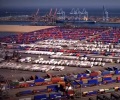

Domestic intermodal container volumes have increased over 7% since Sept. 1, hitting their highest values since December. This may not necessarily be a sign that rail ramp congestion is easing, thanks to the simultaneous decline (22% YoY) in international container volumes, but it may be a positive sign that some supply chain problems like container shortages may not get terribly worse.
Intermodal containers are divided into two groups: domestic and international. The former are owned largely by domestic providers like Union Pacific (NYSE: UNP) and JB Hunt (NASDAQ: JBHT) and remain largely on the North American continent. International containers are the ones you read about being in short supply and owned largely by maritime providers like Maersk. These two container types represent distinct transportation sectors with very different issues.
Domestically speaking, both intermodal container types have a similar problem. Transportation across the country has been hampered by limited drayage capacity, driven by a lack of chassis and driver availability.
These shortages have led to container pileups at rail yards, most notably in the nation’s largest intermodal exchange facilities in Chicago. With no room to place containers, railroads have limited service.
Providers like Union Pacific reported lower volumes (down 6.3%) but much higher revenue per container (up 15%) in their third-quarter earnings from an annual perspective. Price increases and accessorial charges offset the lost revenue from lower volumes.
The international container issues have an added layer of complexity in the way they are direly needed back at their points of origin across the ocean. Maritime trade largely favors a single direction with more freight moving into the U.S. than leaving it. This means shipping companies are struggling to move enough international containers back to their origin countries (mainly China), making them less available for surface transportation and leading to exorbitant prices.
It seems that somewhere along the line, shippers and transportation providers have figured out how to transload more of the international containers (mostly 20-foot and 40-foot) to the larger domestic versions (48-foot and 53-foot) and get them moving across the country.
With more international containers getting back to the places they are needed, upward pricing pressure on rates appears to be easing. The Drewry World Container Index price for shipping 40-foot containers from Shanghai to Los Angeles (SONAR WCI.SHALAX) has dropped 12% over the past month, a strong trend reversal.
The price drop is probably not completely tied to the improvement in moving containers back to China, as demand has eased somewhat off its peak level, thanks in part to the fact many of the goods ordered at this point will not make it to their final destinations in time for the holidays. But, these two items combined could help alleviate some congestion issues starting sooner than many anticipated.
This may not be the big solution everyone wants, but small improvements are still worth celebrating after what has been a long trend of increasing problems for supply chains.
About the Chart of the Week
The FreightWaves Chart of the Week is a chart selection from SONAR that provides an interesting data point to describe the state of the freight markets. A chart is chosen from thousands of potential charts on SONAR to help participants visualize the freight market in real time. Each week a Market Expert will post a chart, along with commentary, live on the front page. After that, the Chart of the Week will be archived on FreightWaves.com for future reference.
SONAR aggregates data from hundreds of sources, presenting the data in charts and maps and providing commentary on what freight market experts want to know about the industry in real time.
The FreightWaves data science and product teams are releasing new data sets each week and enhancing the client experience.
Source: Freight Waves